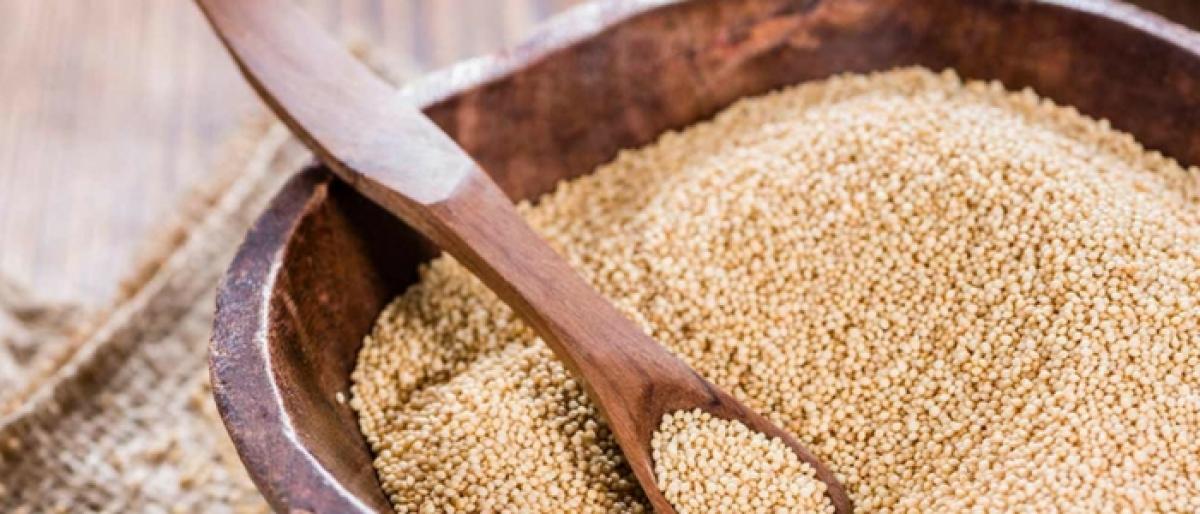Live
- Educating youth about importance of maintaining a healthy liver
- Nine candidates enter the poll fray on first day
- IIT-K, BFI forge partnership to accelerate healthcare innovation
- Nurture self-confidence and growth
- Nominations filed for Kurnool & Nandyal constituencies
- YSRCP’s ‘poor’ candidate owns assets of Rs 161 crore
- 12 nominations filed on Day-1
- Infy profit zooms 30% to ₹ 7,969cr in Q4
- Only 9.83 pc candidates are women in NE states
- YSRCP Bheemili MLA candidate visits various wards
Just In

It’s the month of Shravan in the Hindu calendar and a lot of people are fasting. On the days of the fast, the food is different. The normal wheat flour and rice are substituted with a delicious mouthwatering flour Rajgirah (amaranth).
The flour from Rajgirah (amaranth) seeds is loaded with nutrition and the dishes churned out with this flour is mouthwatering
It’s the month of Shravan in the Hindu calendar and a lot of people are fasting. On the days of the fast, the food is different. The normal wheat flour and rice are substituted with a delicious mouthwatering flour Rajgirah (amaranth).
Luckily for me over the years it's often made in my home and not just during the month of Shravan. Rajgirah is not new to the Indian subcontinent, since generations this flour is made into rotis, pooris, added to sweets especially during Pooja and fasts. Obviously, there was a logical reason behind this and we were clueless about it. My curiosity got me wanting to know more about the nutritional benefits of this amazing flour.
I started researching and found out that it was packed with nutrients and a small amount kept one full for a long time. No wonder it was consumed during fasts when often people ate only one meal in a day and had to feel satiated through the day. Simultaneously the world had discovered an extraordinary heritage super food that they had never seen or heard of before a seed flour called Amaranth.
Health food stores were importing it and were charging a bomb for a packet it. I have gifted a packet. I was wondering what to do with it to my astonishment my home help said ‘oh you have got Rajgirah atta let’s make rotis.’
Though commonly thought of as a grain, Rajgira is, in fact, a leafy green veggie known as amaranth in English. It’s the seed of amaranth that is dried and milled into flour. This seed has properties similar to quinoa but is smaller in size. It’s this flour that is used to make those rajgira rotis, ladoos, chikkis.
Thank god, the world is waking up to Amaranth as it is packed with healthy nutrients like fibre, iron and protein. Internationally it is added to breakfast cereals, granola bars, bread, pasta used as a thickener in soups.
This flour has the highest lysine and amino acid content of all flours making it a good source of protein. Fifteen to seventeen per cent of its weight is protein! It is gluten free and helps the body to absorb calcium, build muscle and produce energy. This seed flour has three times the fibre of wheat. The protein content and fibre reduces insulin levels in the blood stream and releases the hormone that curtails hunger no wonder it is used during fasts since aeons in India.
The flour made from Rajgira seeds are rich in calcium thus reduces the risk of osteoporosis as it contains twice the amount of calcium then milk. Additionally, it contains magnesium, folate, potassium, phosphorus, Vitamins A, C and E and antioxidants. Amaranth also helps reduce bad cholesterol. The vitamin A content makes its beneficial for eyes as well as the skin.
Soak the amaranth seeds in one cup in water for fifteen minutes. To cook, bring the water and grain to a boil and add a pinch of salt and let it simmer for twenty minutes on a slow flame it will yield two and a half cups of the grain. A very versatile food and can be made into pasta, bread, porridges and chapattis.
The seeds can be tossed into salads and soups. I wholly recommend the amaranth flour rotis with a dollop of cows ghee on grown locally the seed and flour is easily available in India at an affordable price we need not buy the imported version as your local grocer would stock it.
Rajgira Paratha
Ingredients
1 cup rajgira flour (amaranth)
1/4 cup boiled, peeled and mashed potatoes
2 tbsp finely chopped coriander (dhania)
1/2 tsp green chillies, finely chopped
1 tsp ghee
½ tsp curd
salt to taste rajgira flour (amaranth) for rolling Ghee for cooking
For Serving: Green chutney, Fresh curd
Method
Combine the rajgira flour, potatoes, green chillies, curd and salt in a bowl and knead into a semi-soft dough using enough water. Divide the dough into equal portions and roll out little thick roti, using a little rajgira flour for rolling. Heat a non-stick tava (griddle) and cook the paratha, using a little ghee, till it turns golden brown in colour from both sides. Serve it with green chutney and fresh curd.

© 2024 Hyderabad Media House Limited/The Hans India. All rights reserved. Powered by hocalwire.com







